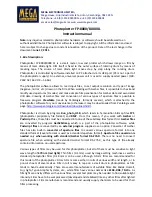
MEGA
ELECTRONICS
LIMITED.,
Mega
House,
Grip
Industrial
Estate,
Linton,
Cambridge,
CB21
4XN
Telephone:
+44
(0)
1223
893900
Fax:
+44
(0)
1223
893894
email:
web:
www.megauk.com
Photoplotter
FP
‐
8000/8000
XL
Instruction
manual
Note:
Any
inquiries
related
to
photoplotter
hardware
or
software
should
be
addressed
to
an
authorized
distributor.
Photoplotter
software
is
subject
to
copyright.
All
the
information
enclosed
here
is
subject
to
change
due
to
constant
innovation
of
the
product.
Date
of
the
last
change
in
this
document:
June
17,
2011.
1.
Brief
description:
Photoplotter
FP
‐
8000/8000
XL
is
a
small,
raster,
low
cost
plotter
which
draws
image
on
film
by
means
of
laser
diode
light.
Film
itself
is
fixed
to
the
outer
surface
of
rotating
drum
by
means
of
masking
tape.
The
source
of
laser
diode
light
moves
step
by
step
along
the
rotating
drum.
Photoplotter
is
controlled
by
software
installed
on
PC
attached
via
its
USB
port
(PC
is
not
a
part
of
the
photoplotter
supply).
An
external,
universal
power
unit
is
used
to
supply
needed
power
(100
‐
240V
AC
/
36V
DC
–
1.66A).
The
photoplotter
software
allows
to
read
input
files,
to
set
output
resolution
and
type
of
image
(negative,
mirror,
etc.)
drawn
on
the
film.
When
working
with
Gerber
files,
it
is
possible
to
check
and
modify
used
apertures
(D
‐
codes)
and
make
simple
film
panelisation
for
Gerber
data
and
associated
drill
data.
Viewing
of
Gerber
files
and
conversion
of
various
types
of
aperture
files
is
possible
in
freeware
program
ViewMate
(made
by
Pentalogix,
formerly
Lavenir),
which
is
attached
to
the
photoplotter
software
for
your
convenience
(otherwise
it
may
be
downloaded
from
Pentalogix
web
page:
http://www.pentalogix.com/Download/download.html
).
Photoplotter
is
driven
by
program
Run_photo_USB
,
which
reads
in
hi
‐
resolution
bitmap
files
FPF
,
(photoplotter
proprietary
file
format)
and
BMP
.
From
this
reason,
if
you
work
with
Gerber
or
Postscript
files,
these
files
must
be
converted
into
one
of
these
bitmap
files
format
first.
Gerber
files
are
converted
by
program
Gerb2bitmap
,
which
is
a
part
of
the
photoplotter
software,
while
Postscript
files
are
converted
by
an
external
program
,
supplied
as
an
option.
Converter
of
Gerber
files
has
also
built
‐
in
converter
of
aperture
files
to
convert
various
aperture
format
into
one
standard
format
(Lavenir
format
is
used
as
a
standard
aperture
format).
Aperture
file
conversion
is
needed
only
when
working
with
standard
Gerber
format
RS
‐
274
‐
D
.
There
is
no
need
to
convert
aperture
file
when
working
with
extended
Gerber
format
RS
‐
274
‐
X,
as
this
type
of
file
already
contains
information
on
used
apertures.
Various
types
of
films
may
be
used
for
this
photoplotter,
but
all
of
them
must
be
sensitive
to
light
wave
length
of
670
nm
(red
light)
.
Thin
films
(0.1
mm)
used
by
image
setting
machines
as
well
as
standard
photoplotter
films
(0.18
mm)
can
be
used,
although
0.1mm
films
are
recommended
for
this
model
of
the
photoplotter.
Films
0.1mm
come
either
in
rolls
of
various
width
and
length,
or
in
pre
‐
cut
sheets
of
several
sizes.
Film
in
roll
is
easy
to
tape
on
a
small
drum
in
photoplotter,
as
film
tends
to
bend
automatically.
There
are
several
manufacturers
of
suitable
films,
like
Kodak,
Horsell,
Fuji,
Agfa,
Typon
Graphic
Systems,
etc.,
while
films
have
various
names
like
EZR4,
RD4,
TR
‐
LR+
.
As
film
light
sensitivity
differs
with
various
films,
several
test
plots
may
be
needed
to
find
suitable
light
intensity.
Films
have
to
be
wet
processed
(developed
and
stabilised)
like
any
other
films
after
lighted
in
photoplotter.
Film
manufacturers
recommend
and
usually
supply
chemicals
to
be
used
for
their
films
processing.
Содержание FP?8000 XL
Страница 12: ......
Страница 20: ...Continue as with any other plot file use Run photoplotter Tools Run Photoplotter or button ...
















